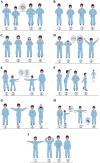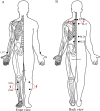Effect of low-moderate intensity traditional Chinese exercises combined with acupuncture on patients with stable chronic obstructive pulmonary disease: study protocol for a randomized controlled trial
- PMID: 40241911
- PMCID: PMC12000029
- DOI: 10.3389/fmed.2025.1470196
Effect of low-moderate intensity traditional Chinese exercises combined with acupuncture on patients with stable chronic obstructive pulmonary disease: study protocol for a randomized controlled trial
Abstract
Background: Traditional Chinese exercises (TCEs), as a new technology for pulmonary rehabilitation, have been proven to be effective in patients with chronic obstructive pulmonary disease (COPD). However, further aggravation of dynamic hyperinflation manifested as exertional dyspnea during exercises may limit the partial therapeutic efficacy of TCEs on patients with COPD. Acupuncture therapy, internationally recognized as a complementary and alternative therapy, can effectively improve the degree of dyspnea, and it is expected to serve as an adjuvant therapy for exercise training in patients with COPD to fully realize the therapeutic efficacy of exercise training. Therefore, this study aims to explore the multidimensional and multi-system effects of the combination of pulmonary-based Qigong (PQ) exercise and acupuncture therapy on patients with COPD.
Methods: This protocol describes an assessor-blinded, data analyst-blinded, four-arm randomized controlled trial that aims to recruit 132 participants with stable COPD and randomly allocate them into pulmonary-based Qigong exercise group, acupuncture group, pulmonary-based Qigong exercise and acupuncture combined group, or control group at a 1:1:1:1 ratio. All participants will receive usual medical care and health education; those in the intervention groups will receive PQ exercise, acupuncture treatment, or a combination of both treatments three times per week for 8 weeks. The primary outcome will be the exercise endurance as assessed by a 6-min walk test. Secondary outcomes will include lung function, degree of dyspnea, diaphragmatic function, respiratory muscle strength, skeletal muscle structure, skeletal muscle function, psychological states, and quality of life. Exploratory outcomes will include the levels of inflammatory mediators. The frequency and severity of acute exacerbations of COPD will be recorded at baseline and 1 year after intervention.
Discussion: The findings of this study will clarify the effects of the combination of PQ exercise and acupuncture therapy on the multi-system function of patients with stable COPD to provide evidence for acupuncture as an adjuvant therapy for pulmonary rehabilitation.
Clinical trial registration: https://www.chictr.org.cn, ChiCTR2300076255.
Keywords: acupuncture; chronic obstructive pulmonary disease; pulmonary rehabilitation; pulmonary-based Qigong exercise; study protocol.
Copyright © 2025 Duan, Bao, Jiang, Li, Wang, He, Deng, Wu, Zhang and Liu.
Conflict of interest statement
The authors declare that the research was conducted in the absence of any commercial or financial relationships that could be construed as a potential conflict of interest.
Figures



Similar articles
-
Effects of combining acupuncture with exercise training on relieving dyspnea and improving exercise tolerance in chronic obstructive pulmonary disease patients: a protocol for a single-blind, randomized, sham-controlled trial.Ann Palliat Med. 2022 Sep;11(9):2968-2979. doi: 10.21037/apm-22-949. Ann Palliat Med. 2022. PMID: 36217626
-
Effects of pulmonary-based Qigong exercise in stable patients with chronic obstructive pulmonary disease: a randomized controlled trial.BMC Complement Med Ther. 2023 Nov 20;23(1):418. doi: 10.1186/s12906-023-04238-8. BMC Complement Med Ther. 2023. PMID: 37985995 Free PMC article. Clinical Trial.
-
Efficacy and cerebral mechanisms of acupuncture for chronic obstructive pulmonary disease: study protocol for a multicenter, randomized controlled neuroimaging trial.Front Neurol. 2024 Jun 26;15:1363225. doi: 10.3389/fneur.2024.1363225. eCollection 2024. Front Neurol. 2024. PMID: 38988597 Free PMC article.
-
Active mind-body movement therapies as an adjunct to or in comparison with pulmonary rehabilitation for people with chronic obstructive pulmonary disease.Cochrane Database Syst Rev. 2018 Oct 10;10(10):CD012290. doi: 10.1002/14651858.CD012290.pub2. Cochrane Database Syst Rev. 2018. PMID: 30306545 Free PMC article.
-
Tailored or adapted interventions for adults with chronic obstructive pulmonary disease and at least one other long-term condition: a mixed methods review.Cochrane Database Syst Rev. 2021 Jul 26;7(7):CD013384. doi: 10.1002/14651858.CD013384.pub2. Cochrane Database Syst Rev. 2021. PMID: 34309831 Free PMC article.
Cited by
-
Psychological nursing effect on chronic obstructive pulmonary disease patients with respiratory failure.Medicine (Baltimore). 2025 Jul 25;104(30):e43515. doi: 10.1097/MD.0000000000043515. Medicine (Baltimore). 2025. PMID: 40725961 Free PMC article. Clinical Trial.
References
-
- GOLD . Global initiative for chronic obstructive lung disease (GOLD). Global strategy for the diagnosis, management and prevention of COPD (2024 report). (2024). Available online at: www.goldcopd.org (Accessed Jan 2024).
-
- Chen S, Kuhn M, Prettner K, Yu F, Yang T, Bärnighausen T, et al. . The global economic burden of chronic obstructive pulmonary disease for 204 countries and territories in 2020–50: a health-augmented macroeconomic modelling study. Lancet Glob Health. (2023) 11:e1183–93. doi: 10.1016/S2214-109X(23)00217-6, PMID: - DOI - PMC - PubMed
LinkOut - more resources
Full Text Sources

